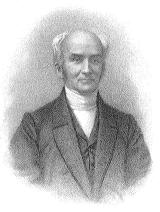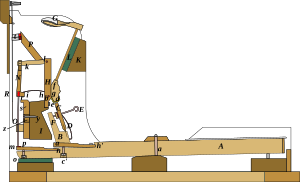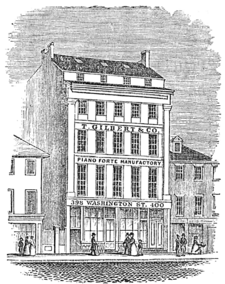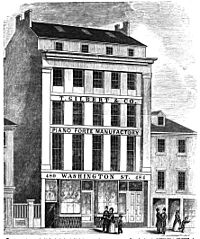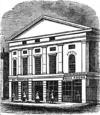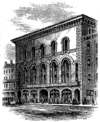Timothy Gilbert facts for kids
Timothy Gilbert (born January 5, 1797 – died July 19, 1865) was an American piano maker. He was also a strong supporter of ending slavery and helped organize religious groups in Boston, Massachusetts. His brother, Lemuel Gilbert, also made pianos.
Contents
Life Story
Timothy Gilbert grew up on his father's farm in Enfield, Massachusetts. When he was 21, he moved to Boston in December 1818. There, he learned how to be a cabinet maker. Later, he worked for a piano maker named John Osborn before starting his own piano business.
Gilbert was a very active member of the Baptist Church. He became a Baptist in 1817 and spoke out strongly against slavery. He even used his home as a safe place for runaway slaves, which was part of the Underground Railroad. When new Fugitive slave laws were passed, Gilbert publicly announced that his home would remain open to help those escaping slavery.
He was also involved in many helpful groups and was president of the Boylston Bank for a few years. He led the Boston Vigilance Committee, a group that helped slaves who had escaped.
Timothy Gilbert married Mary Wetherbee in 1823. They had one child, Mary Eunice. After Mary died, Gilbert married Alice Davis in 1844. They adopted a daughter named Alice and later had another daughter, Martha Fear Gilbert.
Gilbert passed away on July 19, 1865, in his Boston home. His funeral was held at the Tremont Temple, a place he helped create. He is buried in Mount Auburn cemetery.
Making Pianos
Early Days: Currier & Gilbert
Around 1826, Gilbert teamed up with another Boston piano maker, Ebenezer Currier. They had a shop on Washington Street. However, their partnership ended a few years later.
T. Gilbert and T. Gilbert & Co.
After the partnership ended, Gilbert started his own factory. It was in the same building where his old boss, John Osborn, used to work. By 1834, his company became "T. Gilbert & Company." His brother Lemuel and his brother-in-law Henry Safford joined him as partners.
Gilbert's company became known for its pianos. They won awards, including a silver medal in Philadelphia in 1839 for a horizontal piano. In 1841, they won an award in Boston for their square pianos.
Gilbert also invented new things for pianos. In 1841, he patented a way to improve upright pianos. This invention helped the hammers move better and made the keys lighter to touch. He also licensed a special invention called the Aeolian attachment in 1846. This attachment added a small reed organ to a regular square piano, allowing it to be played with the piano keys. It was a new and interesting idea at the time!
William H. Jameson became a partner in the company around 1843. He later married Gilbert's daughter, Mary Eunice.
The Patent Aeolian Pianoforte Manufactory
In 1847, Gilbert & Co. built a large new building for their pianos on Washington Street. It cost about $20,000. The factory was huge, covering over 8,000 square feet, and used steam power for its machines. It was even said that an underground passage in the factory was a secret hiding place for runaway slaves.
By 1848, the company had about 60 workers and had made between 3,000 and 4,000 pianos. More than 500 of these included the special Aeolian attachment.
In 1850, Gilbert's company was doing very well, making $112,500 in sales. This made him the second-largest piano maker in Boston, after Jonas Chickering. By 1851, it was estimated that Gilbert had made over 4,400 pianos.
Gilbert continued to invent. In 1851, he patented new designs for both horizontal and vertical pianos. These designs aimed to make the piano keys even lighter and easier to play. His company also started working with Horace Waters, a piano dealer in New York.
Gilbert & Co. received an honorable mention for a square piano at the Great Exhibition in London in 1851. They also won several other awards for their pianos in the early 1850s.
New Address: 484 Washington Street
In 1853, the street numbers on Washington Street changed, and Gilbert & Company's address became 484 Washington Street.
By 1856, they had made over 6,000 pianos, with about 2,300 of them having the Aeolian attachment. They continued to win awards for their grand pianos and square pianos. In 1859, they advertised that they had made almost 8,000 pianos.
By the early 1860s, Gilbert & Company was still a major piano maker in Boston, but other companies like Chickering & Sons had grown even larger.
Religious Work
The Free Baptist Church
Timothy Gilbert was a dedicated member of the Baptist Church. He left his first church because he disagreed with their views on slavery. He then joined the Federal Street church, which was more aligned with his anti-slavery beliefs. It is said that he even brought African American people to sit in his pew to test if the church would object.
In April 1839, Gilbert left the Federal Street church to help start the Free Baptist Church. This new church was against slavery, did not separate people by race, supported the temperance movement (against alcohol), and was against secret societies. It grew quickly, having 325 members by 1841.
The Tremont Temple
In 1843, Gilbert and a few others bought the old Tremont Theater to create a permanent home for their church. They spent a lot of money to remodel the building, turning it into the Tremont Temple. It opened in December 1843. The church offered free seats and supported itself by renting out shops and offices in the building, as well as its large 2,000-seat hall.
Sadly, the Tremont Temple burned down on March 31, 1852. The fire caused a lot of damage.
A new building was started in May of the same year and was finished in December 1853. The new Tremont Temple had a main hall that could seat 2,500 people, plus two smaller halls. The Young Men's Christian Association even occupied the entire second floor.
Over time, the ownership of the Tremont Temple was transferred to a new group called the Evangelical Baptist Benevolent and Missionary Society. This society made sure the church could continue to offer free services on Sundays.
The second Tremont Temple also burned down in 1879 and was rebuilt. It was destroyed by fire again in 1893.
Fighting Slavery in the Church
Gilbert joined the American Baptist Anti-Slavery Convention, which started in 1840. This group strongly spoke out against slave-holding, causing disagreements within the larger Baptist church. Gilbert believed that the church should not accept money from slaveholders or be associated with them.
He helped collect money for missionaries who were also against slavery. He wanted to make sure that the church was not supporting slavery in any way. Eventually, the Anti-Slavery Convention ended after major changes in the Baptist church, and Gilbert joined the main Missionary Union.


